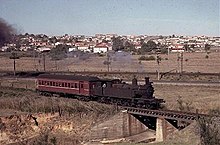New South Wales C30 class locomotive
 From Wikipedia - Reading time: 7 min
From Wikipedia - Reading time: 7 min
| New South Wales C30 class | |||||||||||||||||||||||||||||||||
|---|---|---|---|---|---|---|---|---|---|---|---|---|---|---|---|---|---|---|---|---|---|---|---|---|---|---|---|---|---|---|---|---|---|
 3137 at the NSW Rail Museum, Thirlmere | |||||||||||||||||||||||||||||||||
| |||||||||||||||||||||||||||||||||
| |||||||||||||||||||||||||||||||||
| |||||||||||||||||||||||||||||||||
| |||||||||||||||||||||||||||||||||
The C30 class (formerly S.636 class) is a class of steam locomotives built by Beyer, Peacock & Company and Eveleigh Railway Workshops for the New South Wales Government Railways (NSWGR) of Australia.[1][2][3][4]
These 4-6-4 tank locomotives were specifically designed to haul Sydney's ever increasing suburban traffic, particularly over the heavy grades on the Northern, North Shore and Illawarra lines.
Service
[edit]
The Beyer, Peacock & Company built the first batch of 35 which entered service in 1903/04. Subsequently, between 1905 and 1917, Beyer, Peacock built an additional 60 while the Eveleigh Railway Workshops of the NSWGR built 50 more (3066-3095, 3126-3145).[5]
The inner-city lines' electrification made the locomotives obsolete, but they were too valuable to be withdrawn and scrapped at the time. Therefore, from August 1928 to July 1933, Clyde Engineering and Eveleigh Railway Workshops converted 77 of these locomotives to C30T class 4-6-0 tender locomotives to replace older locomotives on country branch lines.[2][6]
The remaining unaltered locomotives were primarily utilized on Sydney suburban services to Cowan, Penrith, and Campbelltown, as well as branches to Carlingford, Richmond, and Camden.[7] They were also employed on the suburban services in Newcastle and Wollongong.[6]
A few drifted to the country areas, working on sections where no turntable was readily available, such as Casino to Border Loop on the North Coast line, Leeton and Merriwa, and shunting at yards such as Bathurst. Until February 1967, these locomotives operated the daily passenger trains on extremely steep Unanderra to Moss Vale line.[2] Locomotive 3042 was used to haul work trains as part of the electrification of Campbelltown and Glenlee in 1968.[8]
Following the electrification of the country platforms at Sydney Central station, the 30 class replaced the 26 class locomotives used to shunt carriages in the yard; being not as hazardous to water under the traction wiring.[2]
Demise and preservation
[edit]The first example was retired in February 1957, and the engine fleet gradually reduced to 33 by July 1965, and further down to only 3 by mid-1971.[6] Finally, the last engine, No. 3085, was taken out of service on 22 February 1973, making it the second-last steam locomotive to remain in operation on the NSWGR.[9][10]
| No. | Manufacturer | Year | Organisation | Location | Status | Image | Ref |
|---|---|---|---|---|---|---|---|
| 3013 | Beyer, Peacock & Company | 1903 | Privately owned | Canberra | Stored dismantled |  |
[11] |
| 3046 | Beyer, Peacock & Company | 1908 | Dorrigo Steam Railway & Museum | Dorrigo | Stored | [12] | |
| 3085 | Eveleigh Railway Workshops | 1912 | Transport Heritage NSW | Goulburn | Static exhibit | 
|
[13] |
| 3112 | Beyer, Peacock & Company | 1914 | Privately owned | Goulburn | Under overhaul |  |
|
| 3137 | Eveleigh Railway Workshops | 1916 | Transport Heritage NSW | Thirlmere | Static exhibit | [14] |
References
[edit]- ^ Preston, Ron (1984). Tender into Tank. Sydney: New South Wales Rail Transport Museum. pp. 11–57. ISBN 0-909862-18-4.
- ^ a b c d Grunbach, Alex (1989). A Compendium of New South Wales Steam Locomotives. Sydney: Australian Railway Historical Society. pp. 142–145. ISBN 0-909650-27-6.
- ^ New South Wales Railways 1855-1955. Published by Department of Railways New South Wales
- ^ Two Colonies, Three Gauges: A Survey of the Locomotives of William Thow Australian Railway History issue 811 May 2005 pages 230/231
- ^ Standard Passenger Locomotives of the New South Wales Railways Truck & Bus Transportation March 1939 page 32
- ^ a b c Oberg, Leon (1984). Locomotives of Australia 1850's - 1980's. Frenchs Forest: Reed Books. pp. 93–94. ISBN 0-730100-05-7.
- ^ Byways of Steam: Cowan to Hornsby Roundhouse January 1985 page 14
- ^ The Electric Railways of New South Wales: a brief history of the electrified railway system operated by the New South Wales government 1926-1976 - S.E. Dornan & R.G. Henderson, 1976 page 80
- ^ ″Steam Locomotive Data, John Forsyth, Public Transport Commission 1970, 1974
- ^ Railway Digest March 1973
- ^ 3013 Blog Page
- ^ NSW Locomotive, Steam 3046 Australian Steam
- ^ NSW Locomotive, Steam 3085 Office of Environment & Heritage
- ^ NSW Locomotive, Steam 3137 Office of Environment & Heritage
External links
[edit]![]() Media related to New South Wales C30 class locomotives at Wikimedia Commons
Media related to New South Wales C30 class locomotives at Wikimedia Commons
 KSF
KSF